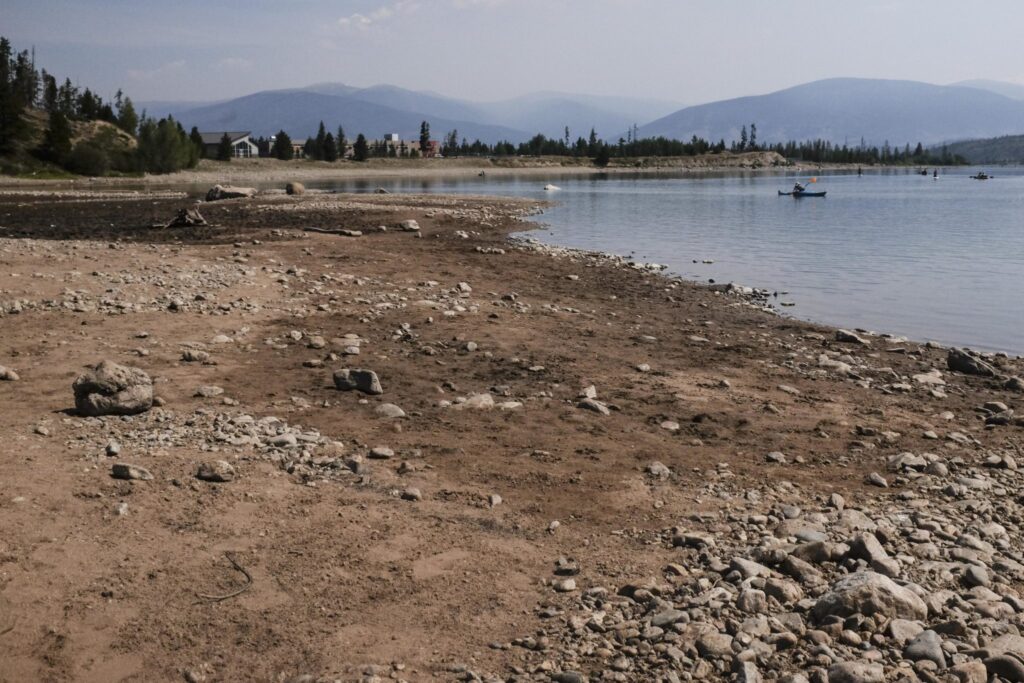
The COVID-19 pandemic has dominated much of life and the economy in 2020, but when it comes to water use along the Front Range, drought is still the ruling force.
Most municipal water providers saw commercial water use plummet at the beginning of the pandemic, but those savings were quickly erased once the hot summer rolled in and the region’s residents switched on their sprinklers.
“The increase in residential and irrigation use have more than offset the decrease in commercial use, resulting in above normal water use across the service area,” said Todd Hartman with Denver Water. “The short story from our perspective is that we are seeing higher use this watering season because of very hot, dry conditions.”
The entire state of Colorado has been under some level of drought since early August, meaning that grass, shrubs and trees need more water than normal. To make up for that increased demand, Front Range communities have to rely more on the Western Slope water contained in their reservoirs.
In a typical year about 48% of Denver’s water comes from the Western Slope, while Colorado Springs pipes in about 75% of its water from the other side of the divide. Fort Collins typically gets more than half of its water from the Western Slope and Aurora Water gets 25% of its water from sources within the Colorado River basin.
Even though most of western Colorado is now in an extreme drought, Front Range water providers are able to rely on their storage from previous years to provide that additional water and then refill the reservoirs during the next snowmelt season.
Northern Water manages the Colorado Big-Thompson project, which pumps water from west of the Continental Divide to municipal and agricultural users along the northern Front Range. During a drought, the water district’s board generally increases the amount of water per share of the project that it doles out, known as a quota, allowing more water to be drawn from its reservoirs and increasing the amount of water delivered to shareholders. In a typical year, the project delivers about 217,000 acre-feet of water to its users. This year, to make up for drought, the board gave users an additional 31,000 acre-feet of water.
“The more water that’s available on the Front Range, like through soil moisture and local storage, the lower the quota we set because the rest of the demand can be furnished by local sources,” said Jeff Stahla with Northern Water. “The drier it is then the higher the quota, because we’re supplementing.”

Outdoor watering dominates
The data from the year so far show just how overwhelming a factor outdoor water use is on overall water-use trends. Even in a pandemic, the watering needs of yards on the Front Range during drought seem to supersede any other behavior changes. In a typical year, 40% of urban water use on the Front Range is for outdoor use. That number often increases during a drought.
Preliminary consumption numbers for the year through August show single-family use up in Denver by about 20% and multi-family use up 5%. Industrial use is down 5%, office buildings are down 9% and restaurants — which remain under limited operations due to the pandemic — are down a whopping 31%. Altogether, Denver Water saw a 12% increase in water use system wide this year, through August. The increase in single-family use began in May when many home irrigation systems were likely first turned on. Other Front Range cities saw similar trends.
Because the pandemic overlapped with a hot, dry summer, it’s been difficult for utilities to determine how much of an effect either event had on overall water use. The most revealing data comes from the spring when businesses closed and most people had yet to turn on their sprinklers.
At Aurora Water, the water conservation team started pulling data early in the pandemic to see if any trends emerged. Between March and April — right as the state transitioned to a stay-at-home order — Aurora saw a commercial water use drop of 14.3% accompanied with an 8.8% increase in residential water use and a 4.6% increase in multi-family use.
But according to Tim York, a water conservation specialist at Aurora Water, the modest increases in residential water use skyrocketed once irrigation season began. Commercial use also ticked back up once businesses began reopening. According to York, Aurora Water saw a 10.3% system-wide increase from January to July that they attribute almost entirely to drought conditions.
“Indoor use kind of is what it is, right? I mean, you’ve got to use the toilet as many times as you need to, you’ve got to do dishes when they’re dirty, you’re going to take your showers just like you normally would, but people react differently to weather,” York said.

‘People are home and wanting to work on their yards’
Most utilities had an adequate amount of water storage going into the summer to make up for the increased water use. Denver, Colorado Springs and Aurora have maintained their normal summer watering restrictions, which include guidelines on when and how often to water outdoors.
On Oct. 1, Fort Collins went under mandatory level IV water restrictions in order to avoid a water shortage in the fall. In most cases residents are no longer allowed to water their lawns and cannot wash their cars. The restrictions are due partially to drought conditions and some planned maintenance on water infrastructure, but the city is also taking preemptive measures to conserve water in case the Cameron Peak Fire begins to affect the water quality in the Poudre River.
Though the drought has been the driving factor in water use this year, water managers say that the pandemic likely did have some effect on behavior and might even pay dividends down the line. Abbye Neel, a water conservation specialist in Fort Collins, says the city has seen a large increase in its Xeriscape Incentive Program. The program provides rebates and project support for Fort Collins residents to redesign their yards to be more water-efficient.
“I have nothing to back this up, but I think it’s just like people are home and wanting to work on their yards,” she said. “There’s a high potential to do more projects this year as people actually get their ducks in a row and sign up.”
Aspen Journalism is a local, nonprofit, investigative news organization. This story initially ran online in the Sky-Hi News on Oct. 3 and in print in the Summit Daily News Oct. 4.
This story was supported by The Water Desk using funding from the Walton Family Foundation.
The Water Desk’s mission is to increase the volume, depth and power of journalism connected to Western water issues. We’re an initiative of the Center for Environmental Journalism at the University of Colorado Boulder. The Water Desk launched in April 2019 with support from the Walton Family Foundation. We maintain a strict editorial firewall between our funders and our journalism. The Water Desk is seeking additional funding to build and sustain the initiative. Click here to donate.





